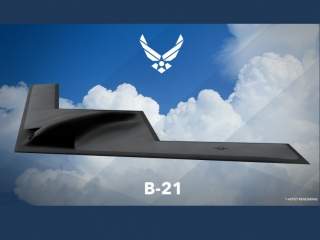The Price of the New B-21 Stealth Bomber? Sorry, That's a Secret.
Even the price is 'stealthy.'
The Senate Armed Services Committee issued a severe blow to transparency and fiscal responsibility last month. In a closed-door vote, they eliminated a requirement to disclose the development cost of the Air Force’s new B-21 stealth bomber. The committee members voted 19 to 7 to prevent the American people from knowing how much of their money will be sunk in this latest questionable weapons project.
Price estimates released for the program so far should give taxpayers cause for concern. Last year the Air Force told Congress the program would cost $33.1 billion. This year they updated their estimate to $58.4 billion—an increase of $25 billion, or 76 percent. The significant difference in the estimates has been attributed to “human error” by the Air Force Secretary, and we can’t help but worry that similar mistakes will flourish in the dark. And an estimate is not the same as the actual contract value. The figures may vary significantly in this case because the Air Force is purchasing the B-21 with a cost-plus contract in which Northrop Grumman will be reimbursed for expenses it incurs during what is expected to be a long development process. This is the information the Senators voted to withhold from taxpayers.
Senate Armed Services Committee Chairman John McCain (R-AZ) had included language in the 2017 National Defense Authorization Act requiring the Air Force to release the dollar amount of the B-21’s Engineering and Manufacturing Development or Congress would withhold funds from the program. “[T]he American people deserve to know how many of their hard earned tax dollars will be spent in these initial phases as we embark on a major defense program expected to exceed $100 billion in total,” the Arizona Senator wrote in a letter to Secretary of the Air Force Deborah Lee James on March 10. He stood firm in his position and was one of the seven to vote against the secrecy provision.
But the Air Force has resisted releasing the figure by claiming the contract price would allow potential adversaries to divine some of the new plane’s capabilities, like its range and how many weapons it can carry. Randall Walden, head of the Air Force’s Rapid Capabilities Office, responded to Senator McCain’s language with a letter saying there is a “strong correlation between the cost of an air vehicle and its total weight.”
As the Project On Government Oversight wrote previously, the Air Force’s argument against releasing the contract price is dubious at best. Officials apparently felt no qualms about releasing an artist’s rendition of the proposed design. They were also eager to announce where some of the plane’s subsystems will be built to begin the process of lining up political support to ensure its survival in future budget battles. Any potential adversary sophisticated enough to figure out the plane’s weight based on the price would certainly be able to learn much more about the plane’s capabilities and how it might perform based on the contractor information the Air Force has chosen to release. I learned a great deal about how the plane will come together after only an hour of Googling.
The American people need to know the contract price to hold those in charge accountable. We applaud Senators McCain, Kelly Ayotte (R-NH), Tom Cotton (R-AR), Joni Ernst (R-IA), Dan Sullivan (R-AK), Lindsey Graham (R-SC), and Ted Cruz (R-TX) for opposing the effort to keep this information from the public. Unfortunately, Senator Bill Nelson (D-FL) was successful in keeping this information secret, garnering the support of Senators James Inhofe (R-OK), Jeff Sessions (R-AL), Roger Wicker (R-MS), Deb Fischer (R-NE), Mike Rounds (R-SD), Thom Tillis (R-NC), Mike Lee (R-UT), Jack Reed (D-CT), Bill Nelson (D-FL), Claire McCaskill (D-MO), Joe Manchin (D-WV), Jeanne Shaheen (D-NH), Kirsten Gillibrand (D-NY), Richard Blumenthal (D-CT), Joe Donnelly (D-IN), Mazie Hirono (D-HI), Tim Kaine (D-VA), Angus King (I-ME), and Martin Heinrich (D-NM).
Defense contractors have a long history of underbidding in order to win contracts. United Technologies Corporation was caught doing so, for instance, when, in the 1980s, the company deliberately low-balled its bid to build F-15 and F-16 engines to win the contract over rival General Electric. A federal judge in Ohio ordered that company to pay $473 million under the False Claims Act in 2013 for misleading the Air Force. This creates problems later when costs inevitably rise once reality asserts itself and it becomes clear the contractors can’t deliver on their promises.
Moreover, there are a number of large programs putting pressure on the Pentagon’s budget, and lawmakers make long-term budgeting decisions with the best information available. When Congress budgets using deliberately understated figures, they end up approving more new programs than we can afford and creating severe problems down the road. Later Congresses are then left to deal with busted budgets, all so a defense contractor could edge out the competition.
We are disappointed with the outcome of this vote, as much by the fact that there wasn’t bipartisan support for disclosure as by the effort to block transparency. National security and open government issues should not be political.
This piece first appeared on the POGO (Project on Government Oversight) website here.

